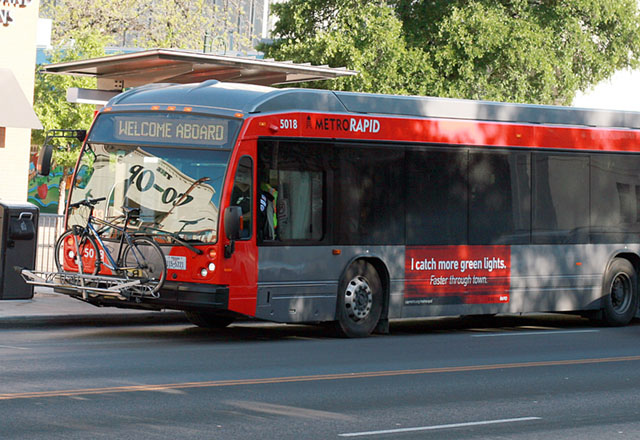As ‘New Bus Smell’ Fades, Complaints Arise on Rapid Bus Service

The MetroRapid attempts to solve the transportation problem that currently affects the city of Austin. The 15-minute intervals are designed to alleviate traffic congestion and bus shortages. Photo by Silvana Di Ravenna.
By Britini Shaw
For Reporting Texas
Austin’s $25 million rapid bus system made a grand entrance in January. But that “new bus smell” has quickly faded, and some Capital Metro customers are complaining, mainly because they lost their old routes and now have to pay 50 percent more for the new premium rides.
The 60-foot-long red and gray buses can hold up to 101 riders, 40 more than regular buses. They are designed to add capacity along one of CapMetro’s busiest travel corridors. The two-section buses have an accordion-like hinge in the middle, so they can maneuver around turns.
The first MetroRapid bus route, 801, runs along North Lamar and South Congress, carrying passengers from the Southpark Meadows station in South Austin to the Tech Ridge station in Far North Austin. As part of the rollout, CapMetro eliminated an express route and combined two other routes, reducing frequency for those buses from every 15 minutes to every 45 minutes.
Under the new system, a day pass costs $3, up from $2 on standard buses. A monthly pass is $49.50 compared to $33 for regular service. One reason for the higher fare is that the MetroRapid buses offer free WiFi Internet service and technology that lets them extend green lights a few seconds if they’re running late. There are fewer stops but the buses come more often, as frequently as every 10 or 12 minutes during peak times. Designated lanes downtown allow them to circumvent traffic.
But the fare increase is problematic for some customers. Mario Rodriguez, who works as a chef at the Central Market on North Lamar, along the 801 route, said it strains his budget.
“Paying the extra, it’s a hard thing,” Rodriguez said. He said he doesn’t use the WiFi service.
Rodriguez has no choice: the route consolidation eliminated his previous stop, and he has no other way to get to his job.
Complaints about the new buses are prevalent online. On reddit.com, comments about the service are mostly negative. Posters complained about longer walks to the new bus stops and the higher fares. People who now ride the consolidated route complained that the buses were crowded and had much longer wait times.
Not everyone is unhappy.
University of Texas education graduate student Ashley Stone, 30, said she likes the WiFi option on the new buses, and said they’ve been less crowded.
“It has been wonderful,” Stone said. “It’s a little more convenient. I use the WiFi to get work done for class and for my job.”
Stone said the MetroRapid may be only slightly faster, but she likes the fact that buses come more often, as well as the digital displays at bus stops that provide real-time information on when the next bus will arrive.
Students at UT and Austin Community College and City of Austin employees ride for free, just as they do on regular CapMetro buses.
Sarah Liguz, who works for the state, rides from the Tech Ridge station to downtown at 6:20 a.m. each workday and returns at 5 p.m.
Although Liguz said she expected the bus to reach its destinations faster she still prefers it to CapMetro’s commuter rail, which she used to ride.
“It’s not too bad. I didn’t realize it would have so many stops,“ Liguz said. “But it beats driving.”
Capital Metro spokeswoman Melissa Ayala said that the MetroRapid buses are a part of plans to increase capacity along high ridership corridors. In an email, Ayala said the goal is to see “daily boardings in excess of 20,000 per day in the 801 corridor within two years of service.”
Asked about rider complaints, she said, “As with any new service, Capital Metro understands riders have to adjust to a new daily commute,”
Ayala said CapMetro gauges public opinion through a community advisory committee. The committee consists of community advocate groups, social service organizations, suburban communities that are part of CapMetro, and transit rider groups.
Ayala said that the new buses have higher service levels and unique features, like the technology that sends a signal to keep lights green a little longer if buses are running behind schedule. The priority lanes downtown also “help keep the service on time,” she said.
In order to help riders get ready for the new route, which debuted Jan. 26, CapMetro sent staff and volunteers to bus stops to talk to passengers and hand out information, and that outreach continued once the service started, Ayala said. CapMetro is continuing to promote the service with billboards and radio ads.
A second MetroRapid route is coming this summer. The 803 route will travel down Burnet Road and South Lamar, going from the Domain shopping center in North Austin to Westgate Mall in South Austin – also a heavily traveled corridor. As with the first rapid bus, some existing routes will be consolidated.
That includes the buses on route 3, which Mario Rodriguez, the Central Market chef, uses to get around town. He says he doesn’t plan to ride the new 803 rapid bus.